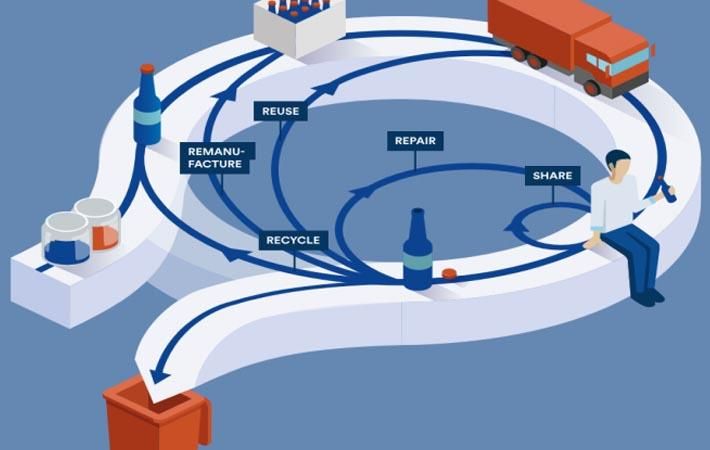Interviews
Manifesto for circularity in global fashion launched
26 May '19
4 min read

Pic: European Commission
Realising the limitations of the linear model in fashion, five leading apparel organisations have come together to release a new policy manifesto for a circular economy in textiles. The manifesto asks the industry to rethink its business model, and policymakers to think beyond existing policy tools based on linear economy to frame a circular fashion system.
The manifesto is the result of collaboration between EURATEX (European Apparel and Textile Confederation), Federation of the European Sporting Goods Industry (FESI), Global Fashion Agenda (GFA), International Apparel Federation (IAF) and Sustainable Apparel Coalition (SAC).
The manifesto aims to accelerate collaboration between the fashion and textiles industries and policymakers. A representative part of the fashion and textile industries is already engaged and committed to this journey, and policymakers have started to scrutinise industry practices. However, the infrastructure and tools to support a scaled circular system are currently inadequate. Businesses of all sizes must work with policymakers and regulators to establish a common framework and clear standards throughout the value chain. Efforts thus far have not achieved enough momentum on this.
The manifesto tackles circularity in three ways. First, it frames the issue by contending that closing the loop requires unprecedented collaboration to combat fashion waste and to guarantee that business models are fully circular, with no broken links. Second, it declares that a new approach must be adopted across the industry by utilising technological innovations in solutions such as separating fibres for reuse and upcycling. Third, the manifesto demands more groundbreaking policy measures tailored to the needs of a diverse range of businesses – from SMEs to multinationals – and smart regulations to nudge consumers to rethink the way they use and dispose of their garments.
The organisations behind the manifesto have committed to developing a European vision for textiles in a circular economy, and they will be expanding on the points outlined in the manifesto over the coming months. This is the beginning of a new approach. Central EU institutions will have new leadership this autumn, making now the time to act to fully realise the opportunities of a circular fashion system. Ultimately, the loop is global, not just regional. To establish a circular economy, a joint global approach to circular fashion is needed.
Eva Kruse, CEO and president, Global Fashion Agenda, says, "This manifesto is extremely significant as it is the first time so many influential organisations in the fashion industry have come together to work with policymakers on a unified approach to circularity. Consumption is only going to grow, and if we do not act now to find a solution to the take-make-dispose model, the strain on our planet will get much worse. We urgently need widespread collaboration between industry and regulators to enact impactful circular solutions, and I hope this manifesto will help to drive change at scale."
Mauro Scalia, director of Sustainable Businesses, EURATEX, says, "We believe joint endeavours can win global challenges. The manifesto shows that finding new ways for unprecedented coordination is possible."
Jérome Pero, secretary general, FESI, states, "Circularity has become a key issue in all aspects of daily life. However, the current schemes in place do not sufficiently support a scaled circular economy system. To drive change, it is essential that all actors work together to make it happen. That's why I believe this manifesto is a perfect, timely call to unite everyone."
Matthijs Crietee, secretary general, IAF, says, "The International Apparel Federation (IAF) firmly supports the manifesto as it clearly recognises the importance of a truly global approach to circularity. So, with a consortium that is both European and global, from the outset the necessary connections between the European actions and those emerging in the rest of the world can be made. IAF will actively use its worldwide network to help create the connections for a global approach to circular fashion."
Baptiste Carrière-Pradal, vice president, SAC, emphasises, "To transform the apparel industry's sustainability performance, brands, retailers and manufacturers must align on assessing impacts with a common framework. Through this European collaboration we can support legislation that promotes lasting industry improvements globally."
Currently, 73 per cent of the world's clothing eventually ends up in landfills and the global fashion industry is projected to grow by 81 per cent by 2030, exerting an unprecedented strain on the planet. The linear model of 'take, make, dispose' will soon reach its physical limits. Circularity is therefore necessary to minimise the use of finite resources. (SV)
The manifesto is the result of collaboration between EURATEX (European Apparel and Textile Confederation), Federation of the European Sporting Goods Industry (FESI), Global Fashion Agenda (GFA), International Apparel Federation (IAF) and Sustainable Apparel Coalition (SAC).
The manifesto aims to accelerate collaboration between the fashion and textiles industries and policymakers. A representative part of the fashion and textile industries is already engaged and committed to this journey, and policymakers have started to scrutinise industry practices. However, the infrastructure and tools to support a scaled circular system are currently inadequate. Businesses of all sizes must work with policymakers and regulators to establish a common framework and clear standards throughout the value chain. Efforts thus far have not achieved enough momentum on this.
The manifesto tackles circularity in three ways. First, it frames the issue by contending that closing the loop requires unprecedented collaboration to combat fashion waste and to guarantee that business models are fully circular, with no broken links. Second, it declares that a new approach must be adopted across the industry by utilising technological innovations in solutions such as separating fibres for reuse and upcycling. Third, the manifesto demands more groundbreaking policy measures tailored to the needs of a diverse range of businesses – from SMEs to multinationals – and smart regulations to nudge consumers to rethink the way they use and dispose of their garments.
The organisations behind the manifesto have committed to developing a European vision for textiles in a circular economy, and they will be expanding on the points outlined in the manifesto over the coming months. This is the beginning of a new approach. Central EU institutions will have new leadership this autumn, making now the time to act to fully realise the opportunities of a circular fashion system. Ultimately, the loop is global, not just regional. To establish a circular economy, a joint global approach to circular fashion is needed.
Eva Kruse, CEO and president, Global Fashion Agenda, says, "This manifesto is extremely significant as it is the first time so many influential organisations in the fashion industry have come together to work with policymakers on a unified approach to circularity. Consumption is only going to grow, and if we do not act now to find a solution to the take-make-dispose model, the strain on our planet will get much worse. We urgently need widespread collaboration between industry and regulators to enact impactful circular solutions, and I hope this manifesto will help to drive change at scale."
Mauro Scalia, director of Sustainable Businesses, EURATEX, says, "We believe joint endeavours can win global challenges. The manifesto shows that finding new ways for unprecedented coordination is possible."
Jérome Pero, secretary general, FESI, states, "Circularity has become a key issue in all aspects of daily life. However, the current schemes in place do not sufficiently support a scaled circular economy system. To drive change, it is essential that all actors work together to make it happen. That's why I believe this manifesto is a perfect, timely call to unite everyone."
Matthijs Crietee, secretary general, IAF, says, "The International Apparel Federation (IAF) firmly supports the manifesto as it clearly recognises the importance of a truly global approach to circularity. So, with a consortium that is both European and global, from the outset the necessary connections between the European actions and those emerging in the rest of the world can be made. IAF will actively use its worldwide network to help create the connections for a global approach to circular fashion."
Baptiste Carrière-Pradal, vice president, SAC, emphasises, "To transform the apparel industry's sustainability performance, brands, retailers and manufacturers must align on assessing impacts with a common framework. Through this European collaboration we can support legislation that promotes lasting industry improvements globally."
Currently, 73 per cent of the world's clothing eventually ends up in landfills and the global fashion industry is projected to grow by 81 per cent by 2030, exerting an unprecedented strain on the planet. The linear model of 'take, make, dispose' will soon reach its physical limits. Circularity is therefore necessary to minimise the use of finite resources. (SV)
Fibre2Fashion News Desk – India
Popular News
Leave your Comments
Editor’s Pick
































-Ltd..jpg?tr=w-120,h-60,c-at_max,cm-pad_resize,bg-ffffff)





.jpg?tr=w-120,h-60,c-at_max,cm-pad_resize,bg-ffffff)
.jpg?tr=w-120,h-60,c-at_max,cm-pad_resize,bg-ffffff)






